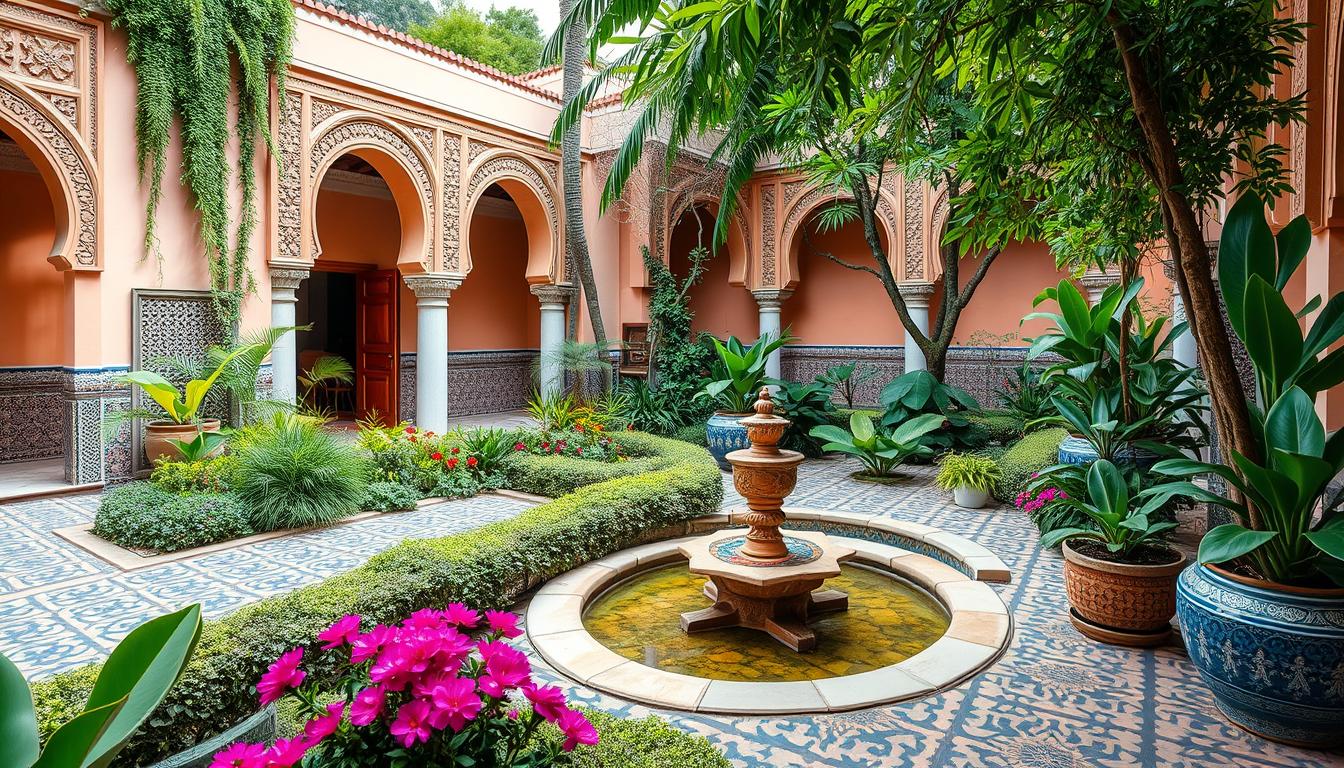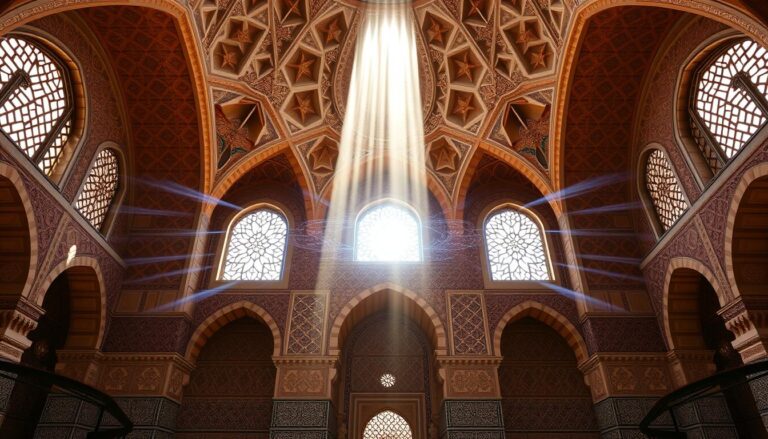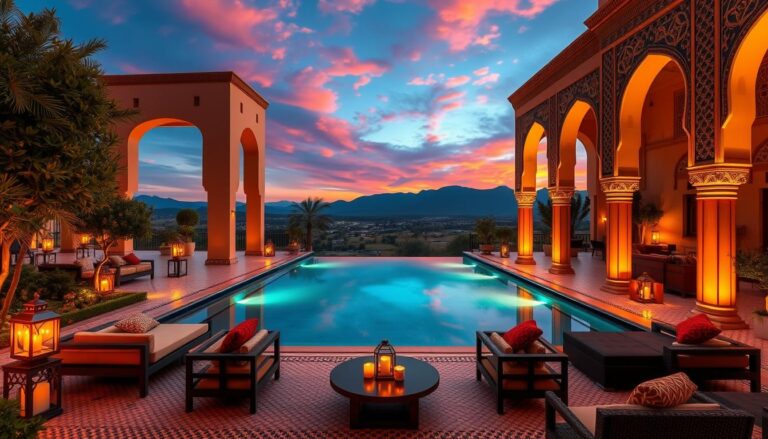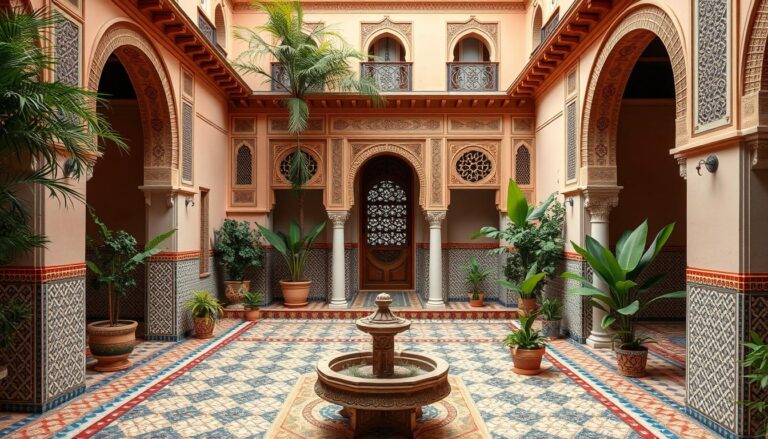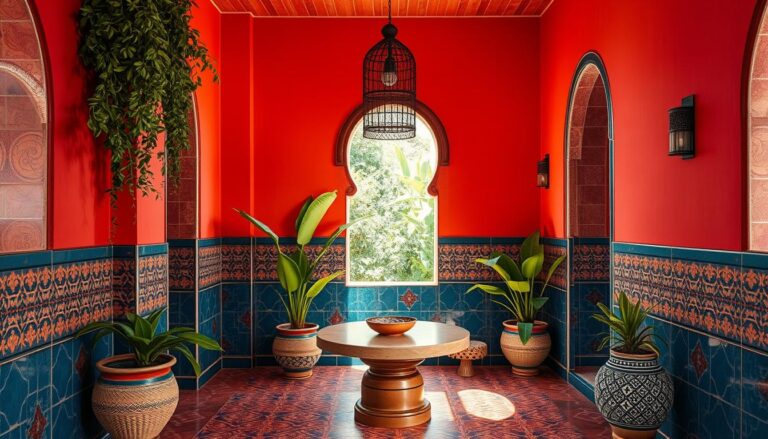Imagine stepping into a world where nature and craftsmanship come together. This world is filled with vibrant colors, intricate patterns, and a soothing calm. Moroccan garden design is a mix of artistic vision and cultural heritage. It’s a place where beauty and history meet.
But what makes these gardens so special? How do they take landscape architecture to new heights? Let’s explore the design principles that make Moroccan gardens a feast for the senses.
Key Takeaways
- Moroccan garden design principles showcase a harmonious integration of artistic creativity, botanical splendor, and cultural heritage.
- The iconic Majorelle Garden in Marrakesh reflects the unique blend of exotic charm, vibrant colors, and intricate patterns in Moroccan outdoor spaces.
- Moroccan gardens feature a rhythmic cascade of water features and an intricate play of shadow and light, creating a mesmerizing sensory experience.
- Landscape architecture in Morocco is deeply rooted in the country’s rich horticultural artistry, where nature and craftsmanship coexist in perfect harmony.
- Exploring the design principles of Moroccan gardens offers insights into the enduring appeal of outdoor living spaces that seamlessly blend beauty, functionality, and cultural identity.
Introduction to Moroccan Garden Design
Origins and Cultural Influences
Moroccan garden design comes from the Islamic tradition of creating beautiful, peaceful spaces. It’s influenced by many cultures, like the Romans and Moors. The Romans brought structured gardens, while the Moors added tilework, water features, and many plants.
The exchange between Moorish Spain and Morocco has shaped Moroccan landscaping. The Generalife Gardens of the Alhambra are a big inspiration. Moroccan gardens have a mix of water, architecture, and plants. You’ll find fruit trees, palm trees, roses, jasmine, and bougainvillea.
“Moroccan garden design is a harmonious blend of Islamic tradition, Moorish influence, and sustainable landscaping principles, creating oases of tranquility and beauty.”
Water features like fountains and pools are key in Moroccan gardens. They symbolize life and vitality. Geometric patterns show order and harmony in the garden’s layout and decorations.
Traditional Moroccan gardens also have mosaic tiles, carved wood, and ornamental stonework. These add beauty and depth to the garden.
Moroccan gardens are designed to work with the local climate. They use plants that don’t need much water and sustainable landscaping. Privacy is important, with high walls, plants, and shaded areas for relaxing and socializing.
The Four Essential Elements
Moroccan garden design is all about four key elements: water, plants, architecture, and geometric patterns. These elements come together to show off Morocco’s rich culture and art. They make the garden a peaceful and beautiful place.
Water, the lifeblood of the garden, is a big part of Moroccan gardens. You’ll find pools, fountains, and rills everywhere. They look good and help keep the garden cool.
- Reflective pools and fountains are central to the Moroccan garden, their shimmering surfaces reflecting the lush plantings and intricate architectural features.
- Rills, or small canals, gently guide water through the garden, adding a soothing melody to the overall experience.
- Water features not only enhance the visual appeal but also play a practical role in cooling the surrounding areas, making the garden a haven from the warm Moroccan climate.
The gardens are full of plantings like fragrant flowers and tall palms. These plants add color and texture. They make the garden feel alive and full of life.
Architectural elements like mosaic tiles and carvings show off Moroccan craftsmanship. These details make the garden look even more beautiful. They highlight the garden’s natural beauty.
Geometric patterns are a big part of Moroccan gardens. These patterns are in the paths and plant arrangements. They bring order and beauty to the garden.
“Moroccan garden design seamlessly blends the elements of water, plants, architecture, and geometry, creating a timeless and captivating outdoor oasis.”
Water: The Soul of the Garden
In Moroccan gardens, water is seen as the soul that brings life and peace. Reflective pools, fountains, and rills are key parts. They are not just for looks but also carry deep meanings tied to Islamic garden design.
The sound of water trickling is enchanting. The reflective surfaces make the garden feel calm and deep. These water features symbolize life’s flow and nature’s purity, echoing Islamic garden design’s core.
Reflective Pools, Fountains, and Rills
Reflective pools are common in Moroccan gardens. They mirror the greenery and buildings around them. The Cambridge mosque has a circular fountain at its heart. It has four paths leading out, showing the connection between heaven and earth.
Fountains add a soothing sound to the garden. Rills, or narrow streams, move water through, bringing life and energy. These features bring peace and a spiritual connection, capturing the heart of Islamic garden design.
“Water and shade are two supreme elements of the Islamic garden, with descriptions in the Quran emphasizing fountains and running water.”
In places where water is scarce, Islamic garden design has adapted. Sometimes, paths replace flowing water. Yet, water’s importance remains, showing its special place in Moroccan garden design.
Lush Plantings: A Celebration of Life
The Moroccan garden is a vibrant mix of life, with Moroccan garden plants like fruit trees and palm trees. These plants create a feast for the senses. They offer a mix of fragrant flowers, color, and texture.
At the garden’s core is the Majorelle Garden, a dream of Jacques Majorelle. Majorelle loved plants and collected many from around the world. This collection adds to the botanical diversity that makes the garden special.
“The Majorelle Garden is a feast for the senses, a celebration of the harmonious coexistence of nature and human artistry.”
Walking through, you’ll smell citrus trees and jasmine and roses. The bright colors of the flowers stand out against the green leaves. It’s a beautiful sight.
The lush plantings in the garden are more than pretty. They show the garden’s role as a safe haven for life. The sounds and sights of nature add to the garden’s peaceful feel.
In the Moroccan garden, life is celebrated through fruit trees, palm trees, and fragrant flowers. This colorful and textured world invites visitors to enjoy nature’s beauty. It’s a place where humans and nature live in harmony.
Architectural Elements: Framing the Natural Beauty
In Moroccan gardens, architecture is key, just like the natural elements. It boosts the garden’s look and shows off Morocco’s rich culture. Zellige, or mosaic tiles, cover walls, floors, and fountains. They bring color and patterns that grab your attention.
Woodwork and stonework add to the garden’s beauty, giving it depth and texture. These details make the garden look better and balance the natural and built parts.
Moroccan garden design mixes Roman, Islamic, and Moorish Spanish styles. This creates a unique and eye-catching landscape. High walls offer privacy, and plants make the garden more appealing.
The central fountain is a key feature, cooling the area. Shaded spots and archways are perfect for relaxing. Moroccan garden architecture blends with nature, offering a peaceful and engaging visit.
Geometric Patterns: The Art of Symmetry
Moroccan garden design is known for its geometric patterns. These patterns show the order and harmony of the universe. They are seen in pathways, garden beds, and how plants and water features are arranged.
These designs bring balance and visual interest to the garden. They reflect Islamic design principles, focusing on harmony and contemplation.
Pathways, Garden Beds, and Plant Arrangement
The geometric patterns in Moroccan gardens are more than just pretty. They also help guide visitors through the garden. The pathways have symmetrical designs that lead to discovery and thought.
The garden beds are set up in geometric patterns too. This creates a sense of order and peace.
When it comes to plant arrangement, symmetry and balance are key. This makes the garden a feast for the eyes. It also shows the Islamic design principles of order and harmony.
“The geometric patterns in Moroccan gardens are not merely decorative; they serve a functional purpose as well, guiding visitors on a journey of discovery and contemplation.”
Moroccan gardens use geometric patterns and symmetrical designs to create balance and visual interest. They also show the Islamic design principles that have shaped the region’s culture.
Garden Design Principles in Moroccan Architecture
Moroccan garden design is loved for its rich history, cultural blend, and connection with nature. Today, designers and garden lovers find inspiration in its ancient wisdom and beauty. These principles help create spaces that are both stunning and eco-friendly.
Adding water features, lush plantings, architectural details, and geometric patterns can turn any outdoor area into a Moroccan oasis. This approach not only makes the garden look amazing but also connects us to Morocco’s timeless traditions and care for the environment.
Embracing the Moroccan Garden Aesthetic
To truly capture the Moroccan garden spirit, consider these elements:
- Reflective pools, fountains, and rills to create a soothing ambiance and a sense of movement
- Lush plantings that celebrate the vibrant diversity of Moroccan flora, including fragrant flowers, towering palms, and verdant foliage
- Architectural features such as ornate archways, tiled pathways, and shaded pavilions to frame the natural beauty
- Geometric patterns and symmetrical designs that echo the rich cultural heritage of Moroccan art and architecture
“The Moroccan garden is not just a collection of plants, but a harmonious fusion of elements that captivates the senses and transports the visitor to a realm of tranquility and beauty.”
By using these Moroccan garden design principles, you can make a beautiful, eco-friendly outdoor space. It celebrates the cultural inspiration and care for the environment found in these timeless designs.
Conclusion
Moroccan garden design beautifully combines nature, art, and spirituality. These gardens, found in cities and deserts, show Morocco’s rich culture and gardening skills. Each part of a Moroccan garden, from water sounds to colors and patterns, holds deep meaning.
Today, people looking to make beautiful and green spaces find inspiration in Moroccan design. By using water, plants, buildings, and patterns, any outdoor area can become a peaceful retreat. This reflects Morocco’s enduring garden tradition.
Moroccan gardens teach us about living in harmony with nature. They show how important it is to be sustainable and in balance. By following these ideas, we can make spaces that are not just pretty but also peaceful and connected to Morocco’s heritage.
Source Links
- 5 Moroccan Garden Ideas To Bring Vibrancy and Warmth
- The Art Of The Moroccan Riad – Metropolis
- Unveiling the Intriguing Beauty of Moroccan Garden Design
- A Slice of Paradise: Moroccan Garden Ideas | With Pics | Blog
- Aesthetic Inspiration and Design Lessons from the Majorelle Garden In Morocco
- Moroccan architecture
- The Timeless Design of Moroccan Homes
- The notion of worth
- The Cambridge Mosque garden, a balm for the soul – FUNCI – Fundación de Cultura Islámica
- 10 Timeless Moorish Garden Design Elements to Elevate Your Outdoor Space
- Untitled
- Studio BO surfs through traditional Moroccan architecture for Tayourt
- Andalusian and Maghrebi Art and Architecture | Islamic Art and Architecture Class Notes | Fiveable
- What is a Riad – The Moroccan Riad | Private Morocco tours
- Desert Blooms: The Contemporary Architecture of Morocco – Architizer Journal
- Morocco: Architecture at its rawest & finest
- The patio house in Morocco: A sustainable design strategy
- Sustainability Principles in Traditional Islamic Architecture
- Passive Strategies for Building Design in Tropical Climates: A Comprehensive Guide

The Editorial Team is a passionate group of Morocco enthusiasts dedicated to sharing the beauty, culture, and wonders of this captivating country. With diverse backgrounds and a deep love for travel, we strive to bring you engaging and informative content that inspires your Moroccan adventures. From uncovering hidden gems and sharing local insights to exploring mouthwatering cuisine and showcasing the vibrant lifestyle, our team is committed to providing you with valuable resources and exciting stories that enhance your exploration of Morocco. Join us on this journey as we celebrate the rich heritage and unforgettable experiences that make Morocco truly special.

